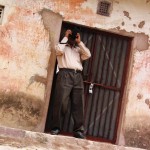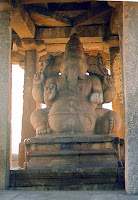Hampi – the lost Vijayanagar Empire
A Lost Empire
Hampi is today a small hamlet in Karnataka (South India) with a population of about two thousand.
It is difficult to visualise that once upon a time, this was the glorious city of Vijayanagar (meaning City of Victory) – the capital of South India’s largest, prosperous and most beautiful empire.
History
The story of Vijayanagar takes us back to the 14th Century.
In 1310 A.D., Malik Kufur, the famous general of Alla-ud-din Khilji, Sultan of Delhi, swept down the Deccan (South India) with his vast armies, defeating and capturing whatever came his way.
Over the next few years, Malik Kufur ended the rule of the Hoyshala and Yadava kings.
No effective leadership remained.
There was utter confusion.
Local chieftains, officials, descendants of old ruling families and opportunists – all tried to take over power.
During that time, Kampila was the ruler of a minor kingdom of the region.
Kampila was killed in war in 1327 A.D. – creating a vacuum.
Two brothers of the Sangama Dynasty, Hukka (1336-56 A.D.) and Bukka (1356-77 A.D.), who were patronized by the Shankaracharya (Hindu religious head) of Sringeri (Mysore), established the Vijayanagar kingdom in 1336 A.D.
Why the brothers selected Hampi is clear.
It is strategically located.
The tempestuous Tungabhadra River forms a natural barrier on the north.
Rocky granite ridges on the other three sides make the area informidable.
Hukka, and after him Bakka, constructed residential complexes, a large number of temples and started massive fortifications.
They raised large armies and expanded their empire far to the south. But they could not penetrate into the North.
Their successors extended the residential complexes and fortifications.And built still more temples!
Devaraya I (1406-22 A.D.) and Devaraya II (1424-46 A.D.) expanded the kingdom eastward to the Bay of Bengal, and westward to the Arabian Sea. During their rule, the kingdom really became an empire.
Later, Krishnadevaraya (1509-29 A.D.), and after him, his half brother Achyutaraya (1529-42 A.D.) raised Vijayanagar empire to its zenith.
Their successor, Ramaraya, son in law of Krishnadevarya, antagonised the Muslim rulers to such an extent that the rulers of Bijapur, Golkonda, Ahmadnagar and Bidar joined together and attacked him.
On 23 January 1565, Ramaraya was killed in the battle of Talikota (100 kilometres north of Hampi).

This defeat was followed by the worse pillage in history. For more than six months, the victors pillaged, looted and burnt the city. So savage and devastating was the destruction that Hampi could never be established again.
World Heritage
In 1986, Hampi was included in the UNESCO list of World Heritage sites.
Today, Hampi is included in UNESCO’s list of endangered sites.
An international team of archaelogists has been working on the site since 1981.
But a lot still remains to be done.
The central part of the township covered an area of about 26 square kilometres.
There were massive walls all round the town.
Hampi had one of the most advanced irrigation systems.
Water from the Tungabhadra River
was used to irrigate the fields.
Agriculture was very good.
The entire metropolis stretched over an area of over 600 square kilometres.
Virupaksha Temple
We can start our sojourn from the Virupaksha temple dedicated to Lord Shiva who is also known as Virupaksha or Pampapathi.
We enter through a gate in the 50 metres high outer tower or gopura.The present tower is imposing, but not very old.
Most of it was constructed during the 19th century.
If you are fortunate, you may be garlanded by the temple elephant much like the Kings used to be welcomed on their return from the various wars they fought.

As we enter, just in front is the coronation hall or mandapa.
The hall has finely carved pillars and paintings on the roofs.
This hall was built by Krishnadevaraya on his coronation in 1510 A.D. and represents true Vijayanagar architecture.
The hall leading to the sanctum sanctorum – the place where the deity is located – has finely carved columns with animals.
This temple is still in use.
There are smaller shrines dedicated to the Goddessess Pampadevi and Bhuvaneshvari and there is the customary temple tank.
To the west of the temple is the Hampi Bazar (market) – a 100 metres long and 35 metres wide market which at one time was flanked on both sides with beautiful houses.
In its days of glory, this was a crowded place.
Apart from fruits, vegetables, meat, cloth and other items of daily necessity, diamonds, pearls, emeralds and rubies were sold here.
Today, it serves much the same purpose.
There are shops selling merchandise of all kinds.
And if you look carefully, in the modern shops and houses, you will discover little remnants of ancient constructions.
The Vithala Temple

The most splendid monument of Hampi is the Vithala Temple Complex.
The 56 pillars in the main hall produce musical notes when struck. To the east of the hall is the famous Stone Chariot with stone wheels that actually revolve!
Hampi is full of such surprises like the King’s Balance, where ruling kings were weighed against grain, gold or money which was then distributed to the poor.
Or the Queen’s Bath, with its arched corridors, projecting balconies and lotus – shaped fountains.

Or the Lotus Mahal in the ‘Zenana’ enclosure – beautiful two-storied place with recessed archways set in geometric regularity and opening out to the sun and the wind like the petals of a flower.

The imposing Elephant Stables have arched entrances and domes.
In the Royal Enclosure of the city is the Hazara Rama Temple.
There are several other
beautiful images
and structures.
Across the Tungabhadra river, in Anegondi, is another complex of ruins that has many small temples.
How to get there
Air
The nearest Airport is Bellary (74 kms).
Other convenient airports are at Belgaum (190 kms), Hubli (160 kms) and Bangalore(353 kms).
Rail
The nearest station is Hospet (13 kms).
Hospet is linked by rail to Bangalore, Bijapur, Hubli and Guntakal.
Road
Hampi is 350 kms from Bangalore.
The road is very good.
Recommendation
Visit the wonderful ruins.
They will transform you into the remote past.
click here to read some one else’s experience in Hampi








Very interesting site. Hope it will always be alive!
Incredible site!
Great site. Good info
Excellent site. It was pleasant to me.
??????????????? – ???????????????!
……………………Great site………………………….
viagra
Incredible site!
Great site. Good info
If you have to do it, you might as well do it right
xanax